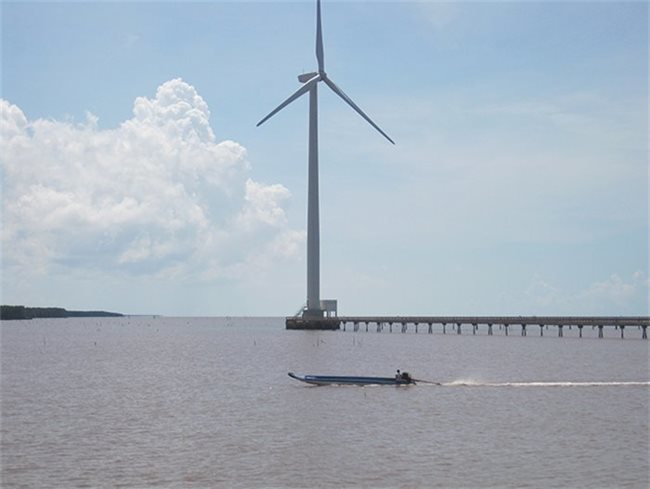 |
| A wind power turbine of a wind park in the Mekong Delta |
Renewable energy used in Vietnam remains at less than 10%, not including hydroelectric power. This is lagging far behind the potential in the sector, Jérôme Pécresse, president and CEO of GE Renewable Energy, told Saigon Times recently.
Pécresse said there are two reasons for this. Firstly, there is an installed base of fossil fuel power capacity, particularly coal fired plants, which still produce predominant amounts of power.
Secondly, it takes much time to complete the projects, especially in wind power. It remains difficult to receive approval for projects, because there remains a number of administrative requirements which must be fulfilled.
It was noted that Vietnam, with its long coastline, is one of the nations in Southeast Asia having the potential to produce large amounts of renewable energy.
Vietnam has tremendous natural resources—four to five kilowatt-hours per square meter for solar and 3,000 kilometers of coastlines with consistent winds in the range of 5.5 to 7.3 meters per second - creating opportunities for solar and wind generation in Vietnam, noted McKinsey and Company’s renewable energy report, released early this year.
Vietnam’s current power plan requires an investment of roughly US$150 billion by 2030 in additional generation assets and grid infrastructure.
The power-generation investments focus largely on coal (about 45 additional gigawatts by 2030) and, to a lesser extent, renewables (18 gigawatts by 2030).
Vietnam continues lagging behind neighboring countries, such as Thailand, which aims to have renewable energy account for 30% of final energy consumption by 2036.
“Historically, the reason why you don’t have more wind generation is because there is a bottleneck in terms of project approval,” Pécresse said. The process to develop wind power should be faster.
Two years ago, there was very strong development in Thailand, which has now slowed due to a combination of less financing being available and a less favorable regulatory regime.
“So, I think when I compare it to two years ago, Vietnam is developing much more momentum for solar and for wind”, said the head of GE Renewable Energy, during a business trip to Vietnam this week.
With over 4 gigawatts, Vietnam has installed more solar capacity than most countries in Southeast Asia. In terms of wind potential, onshore, nearshore and, in the long term, offshore, given the coast and the quality of the wind, Vietnam has more potential for wind power thanks to the quality of its human resources and the availability of local financing, as well as the interest of financing from outside Vietnam.
Renewable energy development in Vietnam raises concerns over the capacity of the local grid to accommodate intermittent power. However, GE Vietnam is conducting some studies with Vietnam Electricity Corporation (EVN) and the government to assess the impact of renewable energy to the grid.
“We are confident that the gain in Vietnam can accommodate the level of penetration of renewables of 20%, and even 30% of installed capacity with modern investments”, Pécresse said.
GE Vietnam has not been active in developing solar power in Vietnam, with only two projects of 50 megawatt each in solar power. However, the company has 30% of the local wind power market. SGT
Thuy Dung
 Vietnam has very large potentials to increase the generation of electricity from wind and the sun. However, the reason for the lack of progress is cumbersome administrative procedures.
Vietnam has very large potentials to increase the generation of electricity from wind and the sun. However, the reason for the lack of progress is cumbersome administrative procedures.